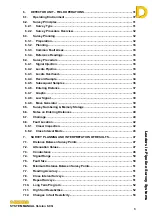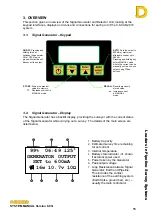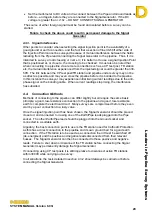
Leaders in Pipelin
e Survey Systems
C
C
C
-
-
-
S
S
S
C
C
C
A
A
A
N
N
N
2
2
2
0
0
0
1
1
1
0
0
0
SYSTEM MANUAL Version 6.03i
8
1.2. Detector Unit
The Detector Unit is housed in a weatherproof plastic case.
The front tube contains the antenna system, and the keyboard and LCD display are
mounted on the top of the tube with the main computer and GPS system. The base
compartment contains the communications and charger computer, the batteries and
connectors.
Fig. 1.2 – Detector Unit
The antenna consists of a number of large diameter air cored coils.
In operation, the computer calculates the vector sum of the field strengths measured by
the coils over the length of the instrument. The Detector display (as shown on page 17)
indicates to the operator the location of the pipeline and its approximate distance away,
guiding the operator towards the pipeline. When the field measured by the vertical axis
coil falls below a threshold value, the instrument display changes; the
pipeline position
indicator
shows the pipeline in the centre of the display and the
overhead location bars
begin to close. When these bars are as close together as possible, the Detector is
positioned in the vertical centreline of the pipeline.
When the Detector is stationary in this ‘
overhead
’ position, a sample of 300 readings of the
field strength values can be taken over a period of approximately six seconds. The
computer will then calculate the depth of the pipeline (from the base of the Detector to the
centre line of the pipeline) and the strength of the residual signal current on the pipe.
The ‘DEPTH’ and ‘CURRENT’ values (in feet and mA) are shown on the LCD.
Using the keyboard, and following the prompts appearing on the display, the operator can
store the displayed data (which is automatically given a reference number), and request
the computer to calculate the logarithmic attenuation of the signal from any previous
location stored in its memory. This information is displayed on the LCD and is also stored.
The total number of points or surveys that Detector can hold in its memory is 500 points
spread over 100 surveys (whichever number is reached first), so although it is unlikely that
a surveyor will run out of memory, it is advisable to download the data and clear the
memory after each survey or survey series. Each survey data point contains the location
Display and Keypad
Carrying Handle
Battery Compartment
USB PC Connection
Battery Charger port












































